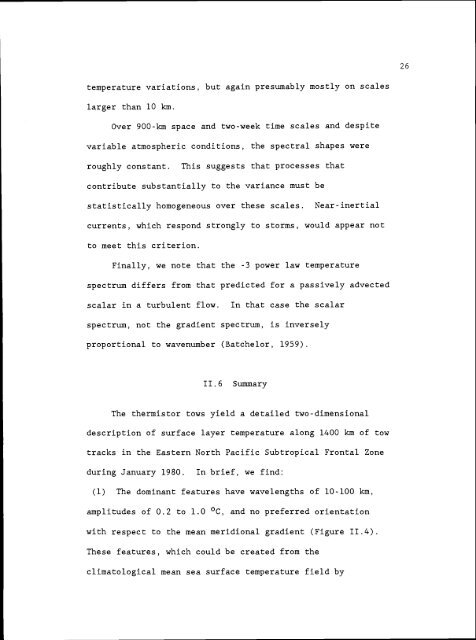Observations and Modelling of Fronts and Frontogenesis
Observations and Modelling of Fronts and Frontogenesis
Observations and Modelling of Fronts and Frontogenesis
You also want an ePaper? Increase the reach of your titles
YUMPU automatically turns print PDFs into web optimized ePapers that Google loves.
temperature variations, but again presumably mostly on scales<br />
larger than 10 km.<br />
Over 900-km space <strong>and</strong> two-week time scales <strong>and</strong> despite<br />
variable atmospheric conditions, the spectral shapes were<br />
roughly constant. This suggests that processes that<br />
contribute substantially to the variance must be<br />
statistically homogeneous over these scales. Near-inertial<br />
currents, which respond strongly to storms, would appear not<br />
to meet this criterion.<br />
Finally, we note that the -3 power law temperature<br />
spectrum differs from that predicted for a passively advected<br />
scalar in a turbulent flow. In that case the scalar<br />
spectrum, not the gradient spectrum, is inversely<br />
proportional to wavenumber (atchelor, 1959).<br />
11.6 Summary<br />
The thermistor tows yield a detailed two-dimensional<br />
description <strong>of</strong> surface layer temperature along 1400 km <strong>of</strong> tow<br />
tracks in the Eastern North Pacific Subtropical Frontal Zone<br />
during January 1980. In brief, we find:<br />
(1) The dominant features have wavelengths <strong>of</strong> 10-100 km,<br />
amplitudes <strong>of</strong> 0.2 to 1.0 °C, <strong>and</strong> no preferred orientation<br />
with respect to the mean meridional gradient (Figure 11.4).<br />
These features, which could be created from the<br />
climatological mean sea surface temperature field by<br />
26















